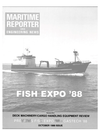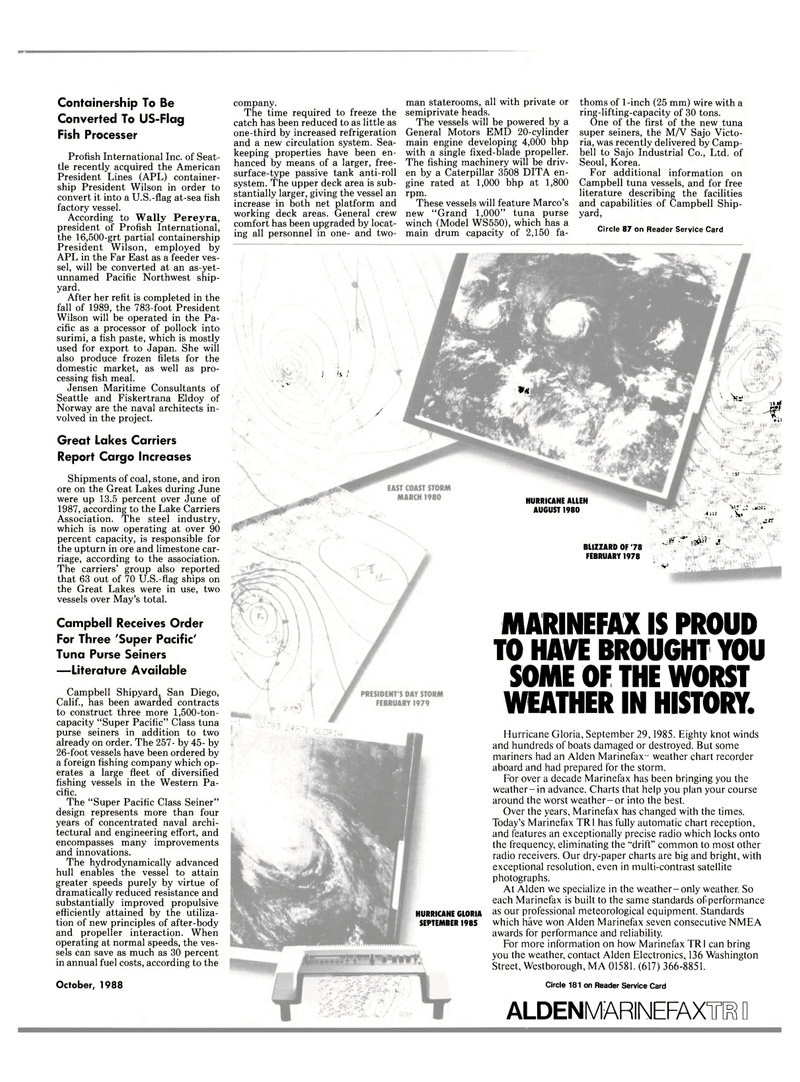
Page 3: of Maritime Reporter Magazine (October 1988)
Read this page in Pdf, Flash or Html5 edition of October 1988 Maritime Reporter Magazine
Containership To Be
Converted To US-Flag
Fish Processer
Profish International Inc. of Seat- tle recently acquired the American
President Lines (APL) container- ship President Wilson in order to convert it into a U.S.-flag at-sea fish factory vessel.
According to Wally Pereyra, president of Profish International, the 16,500-grt partial containership
President Wilson, employed by
APL in the Far East as a feeder ves- sel, will be converted at an as-yet- unnamed Pacific Northwest ship- yard.
After her refit is completed in the fall of 1989, the 783-foot President
Wilson will be operated in the Pa- cific as a processor of pollock into surimi, a fish paste, which is mostly used for export to Japan. She will also produce frozen filets for the domestic market, as well as pro- cessing fish meal.
Jensen Maritime Consultants of
Seattle and Fiskertrana Eldoy of
Norway are the naval architects in- volved in the project.
Great Lakes Carriers
Report Cargo Increases
Shipments of coal, stone, and iron ore on the Great Lakes during June were up 13.5 percent over June of 1987, according to the Lake Carriers
Association. The steel industry, which is now operating at over 90 percent capacity, is responsible for the upturn in ore and limestone car- riage, according to the association.
The carriers' group also reported that 63 out of 70 U.S.-flag ships on the Great Lakes were in use, two vessels over May's total.
Campbell Receives Order
For Three 'Super Pacific'
Tuna Purse Seiners —Literature Available
Campbell Shipyard, San Diego,
Calif., has been awarded contracts to construct three more 1,500-ton- capacity "Super Pacific" Class tuna purse seiners in addition to two already on order. The 257- by 45- by 26-foot vessels have been ordered by a foreign fishing company which op- erates a large fleet of diversified fishing vessels in the Western Pa- cific.
The "Super Pacific Class Seiner" design represents more than four years of concentrated naval archi- tectural and engineering effort, and encompasses many improvements and innovations.
The hydrodynamically advanced hull enables the vessel to attain greater speeds purely by virtue of dramatically reduced resistance and substantially improved propulsive efficiently attained by the utiliza- tion of new principles of after-body and propeller interaction. When operating at normal speeds, the ves- sels can save as much as 30 percent in annual fuel costs, according to the
October, 1988 5 company.
The time required to freeze the catch has been reduced to as little as one-third by increased refrigeration and a new circulation system. Sea- keeping properties have been en- hanced by means of a larger, free- surface-type passive tank anti-roll system. The upper deck area is sub- stantially larger, giving the vessel an increase in both net platform and working deck areas. General crew comfort has been upgraded by locat- ing all personnel in one- and two- man staterooms, all with private or semiprivate heads.
The vessels will be powered by a
General Motors EMD 20-cylinder main engine developing 4,000 bhp with a single fixed-blade propeller.
The fishing machinery will be driv- en by a Caterpillar 3508 DITA en- gine rated at 1,000 bhp at 1,800 rpm.
These vessels will feature Marco's new "Grand 1,000" tuna purse winch (Model WS550), which has a main drum capacity of 2,150 fa- thoms of 1-inch (25 mm) wire with a ring-lifting-capacity of 30 tons.
One of the first of the new tuna super seiners, the M/V Sajo Victo- ria, was recently delivered by Camp- bell to Sajo Industrial Co., Ltd. of
Seoul, Korea.
For additional information on
Campbell tuna vessels, and for free literature describing the facilities and capabilities of Campbell Ship- yard,
Circle 87 on Reader Service Card • V * i ' / #4 • V
Jf M ctl • :v
V? .tor. Ju! V iff
HURRICANE ALLEN
AUGUST 1980
BLIZZARD OF '78
FEBRUARY 1978 , * * / . V *
HURRICANE GLORIA
SEPTEMBER 1985
MARINEFAX IS PROUD
TO HAVE BROUGHT YOU
SOME OF THE WORST
WEATHER IN HISTORY.
Hurricane Gloria, September 29,1985. Eighty knot winds and hundreds of boats damaged or destroyed. But some mariners had an Alden Marinefax weather chart recorder aboard and had prepared for the storm.
For over a decade Marinefax has been bringing you the weather-in advance. Charts that help you plan your course around the worst weather-or into the best.
Over the years, Marinefax has changed with the times.
Today's Marinefax TRI has fully automatic chart reception, and features an exceptionally precise radio which locks onto the frequency, eliminating the "drift" common to most other radio receivers. Our dry-paper charts are big and bright, with exceptional resolution, even in multi-contrast satellite photographs.
At Alden we specialize in the weather-only weather. So each Marinefax is built to the same standards of performance as our professional meteorological equipment. Standards which have won Alden Marinefax seven consecutive NMEA awards for performance and reliability.
For more information on how Marinefax TRI can bring you the weather, contact Alden Electronics, 136 Washington
Street, Westborough, MA 01581. (617) 366-8851.
Circle 181 on Reader Service Card
ALDENMARINEFAXTO 0

 2
2

 4
4
